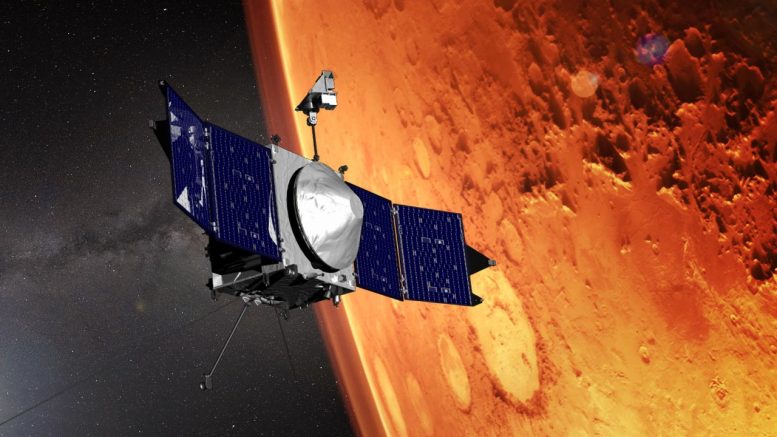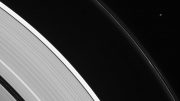
This illustration shows NASA’s MAVEN spacecraft and the limb of Mars. Credit: NASA/Goddard
Scheduled to launch in late 2013, NASA’s MAVEN spacecraft will study the Martian upper atmosphere in detail, gathering information about relevant processes so scientists can infer how the planet’s atmosphere evolved.
When the Mars Atmosphere and Volatile Evolution (MAVEN) mission begins its journey to the Red Planet in 2013, it will carry a sensitive magnetic-field instrument built and tested by a team at NASA’s Goddard Space Flight Center in Greenbelt, Maryland.
Scheduled for launch in late 2013, MAVEN will be the first mission devoted to understanding the Martian upper atmosphere.
The goal of MAVEN is to determine the history of the loss of atmospheric gases to space through time, providing answers about Mars’ climate evolution.
By measuring the current rate of escape to space and gathering enough information about the relevant processes, scientists will be able to infer how the planet’s atmosphere evolved.
The trip to Mars takes 10 months, and MAVEN will go into orbit around the planet in September 2014.
When you navigate with a compass you can orient yourself thanks to Earth’s global magnetic field. But on Mars, if you were to walk around with a compass it would haphazardly point from one anomaly to another, because the Red Planet does not possess a global magnetosphere. Scientists think that this lack of a protective magnetic field may have allowed the solar wind to strip away the Martian atmosphere over billions of years, and now NASA’s MAVEN spacecraft will study this process in detail with its pair of ring core fluxgate magnetometers. Credit: NASA/Goddard/Dan Gallagher
The Goddard-built MAVEN magnetometer will be a sensitive tool investigating what remains of the Red Planet’s magnetic “shield.” It will play a key role in studying the planet’s atmosphere and interactions with solar wind, helping answer the question of why a planet once thought to have an abundance of liquid water became a frozen desert.
“The MAVEN magnetometer is key to unraveling the nature of the interactions between the solar wind and the planet,” said MAVEN principal investigator Bruce Jakosky from University of Colorado at Boulder’s Laboratory for Atmospheric and Space Physics (CU/LASP).
The magnetometer will measure the planet’s magnetic field through a series of coils, each containing a magnetic ring wrapped around a metal core. The sensors, known as “flux gates,” are driven in and out of saturation by applied magnetic fields.
If there is no ambient magnetic field, the sensors remain balanced. If there is an ambient field present, the sensors will go into saturation more quickly in one direction than the other. It’s the imbalance that reveals the presence of an ambient field.
“A magnetometer is like an electronic compass,” said Jack Connerney, mission co-investigator at Goddard. “But we measure the strength, as well as the direction, of the magnetic field.”
The importance of studying the planet’s magnetic field is rooted in the theory that Mars lost its global magnetic field billions of years ago, allowing the solar wind to strip the atmosphere and dry out the planet.
Unlike Earth’s global magnetic field, which surrounds the entire planet, Mars only has patches of magnetic field left in its crust. This can create pockets of atmosphere that are protected against solar wind and others that are left vulnerable.
By measuring sections of the planet’s magnetic field, the magnetometer could help scientists create a bigger picture of the planet’s overall atmosphere.
“The magnetometer helps us see where the atmosphere is protected by mini-magnetospheres and where it’s open to solar wind,” Connerney said. “We can study the solar wind impact and how efficient it is at stripping the atmosphere.”
The magnetometer is one of six instruments that make up the Particles and Fields Package, being assembled by team members at the University of California, Berkeley. The magnetometer works with the other instruments from this package to gather data throughout the course of the projected yearlong orbit around the planet.
The spacecraft will go into orbit and pass closely over the planet’s surface and then move further away to study solar wind beyond the planet’s influence.
The magnetometer is a very sensitive instrument, so engineers have to work to ensure the instrument doesn’t accidentally measure the spacecraft’s magnetic field instead of the one the planet produces.
“We have to go to great extremes to be sure that we have minimized any magnetic fields from the spacecraft,” Jakosky said. “We are working hard to build a very ‘magnetically clean’ spacecraft that will meet our needs with regard to the magnetometer.”
The MAVEN principal investigator comes from CU/LASP. The university provides science operations, is building science instruments, and leads education/public outreach. NASA Goddard manages the project and is building two of the science instruments for the mission. Lockheed Martin of Littleton, Colo., is building the spacecraft and is responsible for mission operations. The University of California at Berkeley Space Sciences Laboratory is building science instruments for the mission. NASA’s Jet Propulsion Laboratory, Pasadena, California, provides navigation support, the Deep Space Network, and the Electra telecommunications relay hardware and operations.









Be the first to comment on "NASA’s MAVEN Spacecraft to Study Martian Atmosphere"